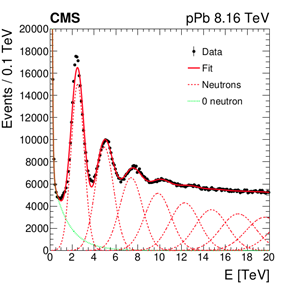Performance analysis of the CMS Zero Degree Calorimeters (ZDC)
We published a paper on the subject [1]. In this paper we present our studies of the CMS ZDC using proton-lead collisions measured in 2016. First, we developed a template fitting method, which can be used to extract accurate values of the ZDC signals in the presence of collisions preceding our main signal. We also improved the Monte Carlo simulation of the ZDC, including the modeling of Cherenkov photons. We have shown that the properties of the measured ZDC signals can be reproduced by this simulation and can be used to match the gains of the ZDC channels. As a result, we measured the energy distribution of neutrons emitted from the collisions at shallow angles; we have found peaks corresponding to single, double and triple neutron events (Fig. 1). Finally, we studied the effect of multiple simultaneous collisions and derived a Fourier deconvolution formula to correct the measured energy distribution in the ZDC. The corrected spectrum can be used to determine the centrality of p-Pb collisions.

ALICE ITS3 and ALICE3
We are participating in the development of the cooling system of the third generation of the Inner Tracking System of the ALICE experiment. The new detector will greatly reduce material budget with the use of the new flexible silicon detector technology. The future ALICE 3 experiment that will replace the current detector system will be fully based on semiconducting technology. We contribute to its development with performance studies that will make part of the Letter of Intent.
CMS DOROS
The CMS DOROS (Diode ORbit and OScillation) detectors, playing a crucial role as part of Beam Position Monitors, are designed to measure the exact position of the proton beams, while the instantaneous luminosity can be estimated by monitoring the occupancy of the CMS Pixel Detector system. We worked on improvements of the signals from both detectors to increase performance for the upcoming Run 3 data taking period.
[1] Surányi O et al. incl. Siklér F, JINST 16 (2021) P05008
